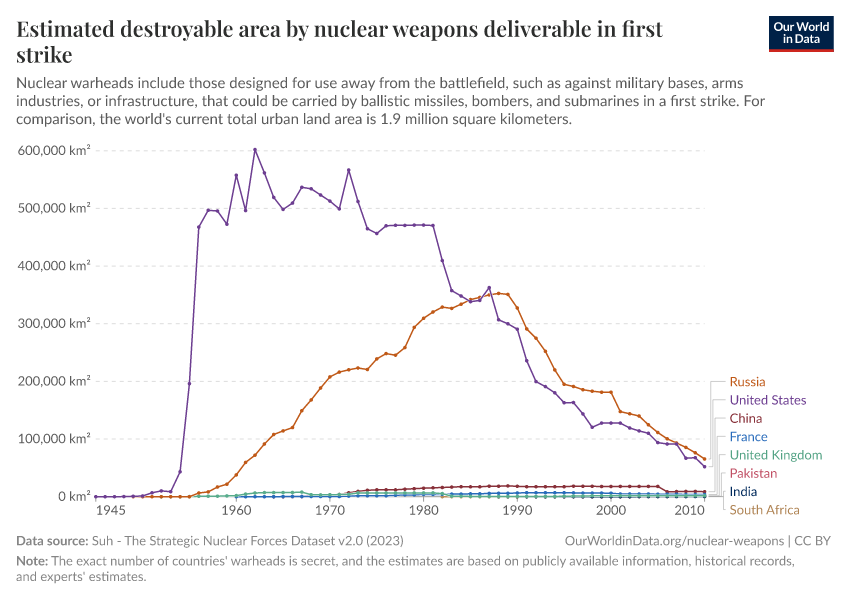Estimated destroyable area by nuclear weapons deliverable in first strike

What you should know about this indicator
- This data refers to the destruction of unprotected structures, such as building and factories.
- For reference, the world's current total urban land area is around 1.9 million square kilometers.
- We calculate the destroyable area by multiplying the equivalent megatonnage of all warheads with the approximate area destroyed by one megaton (20 square miles) and then converting it into square kilometers.
- A "megaton" is the explosive energy released by one million tons of TNT. For comparison, the bombs dropped on Hiroshima and Nagasaki were 0.015 and 0.021 megatons, respectively.
- An equivalent megaton is a way of making the explosive energy of different warheads comparable. It weighs small warheads — in this case those with at most one megaton — more than large ones, because they are relatively more destructive.
- The warheads included here are strategic ones — those designed for use away from the battlefield, such as against military bases, arms industries, or infrastructure.
- Only those strategic warheads are included that could be deployed — those that could be carried by ballistic missiles, bombers, and submarines in one strike.
- The exact number of countries' warheads is secret, and the estimates are based on publicly available information, historical records, and experts' estimates.
What you should know about this indicator
- This data refers to the destruction of unprotected structures, such as building and factories.
- For reference, the world's current total urban land area is around 1.9 million square kilometers.
- We calculate the destroyable area by multiplying the equivalent megatonnage of all warheads with the approximate area destroyed by one megaton (20 square miles) and then converting it into square kilometers.
- A "megaton" is the explosive energy released by one million tons of TNT. For comparison, the bombs dropped on Hiroshima and Nagasaki were 0.015 and 0.021 megatons, respectively.
- An equivalent megaton is a way of making the explosive energy of different warheads comparable. It weighs small warheads — in this case those with at most one megaton — more than large ones, because they are relatively more destructive.
- The warheads included here are strategic ones — those designed for use away from the battlefield, such as against military bases, arms industries, or infrastructure.
- Only those strategic warheads are included that could be deployed — those that could be carried by ballistic missiles, bombers, and submarines in one strike.
- The exact number of countries' warheads is secret, and the estimates are based on publicly available information, historical records, and experts' estimates.
Sources and processing
This data is based on the following sources
How we process data at Our World in Data
All data and visualizations on Our World in Data rely on data sourced from one or several original data providers. Preparing this original data involves several processing steps. Depending on the data, this can include standardizing country names and world region definitions, converting units, calculating derived indicators such as per capita measures, as well as adding or adapting metadata such as the name or the description given to an indicator.
At the link below you can find a detailed description of the structure of our data pipeline, including links to all the code used to prepare data across Our World in Data.
Notes on our processing step for this indicator
- The area that can be destroyed by nuclear weapons of a certain yield is calculated based on Richelson, Jeffrey. 1980. Evaluating the Strategic Balance. American Journal of Political Science 24(4): 782. We assume each equivalent megaton can destroy 20 square miles, which is equivalent to 51.8 square kilometers.
Reuse this work
- All data produced by third-party providers and made available by Our World in Data are subject to the license terms from the original providers. Our work would not be possible without the data providers we rely on, so we ask you to always cite them appropriately (see below). This is crucial to allow data providers to continue doing their work, enhancing, maintaining and updating valuable data.
- All data, visualizations, and code produced by Our World in Data are completely open access under the Creative Commons BY license. You have the permission to use, distribute, and reproduce these in any medium, provided the source and authors are credited.
Citations
How to cite this page
To cite this page overall, including any descriptions, FAQs or explanations of the data authored by Our World in Data, please use the following citation:
“Data Page: Estimated destroyable area by nuclear weapons deliverable in first strike”, part of the following publication: Bastian Herre, Pablo Rosado, and Max Roser (2024) - “Nuclear Weapons”. Data adapted from Suh. Retrieved from https://archive.ourworldindata.org/20250909-093708/grapher/estimated-destroyable-area-by-nuclear-weapons-deliverable-in-first-strike.html [online resource] (archived on September 9, 2025).How to cite this data
In-line citationIf you have limited space (e.g. in data visualizations), you can use this abbreviated in-line citation:
Suh - The Strategic Nuclear Forces Dataset v2.0 (2023) – with major processing by Our World in DataFull citation
Suh - The Strategic Nuclear Forces Dataset v2.0 (2023) – with major processing by Our World in Data. “Estimated destroyable area by nuclear weapons deliverable in first strike” [dataset]. Suh, “The Strategic Nuclear Forces Dataset v2.0” [original data]. Retrieved December 29, 2025 from https://archive.ourworldindata.org/20250909-093708/grapher/estimated-destroyable-area-by-nuclear-weapons-deliverable-in-first-strike.html (archived on September 9, 2025).